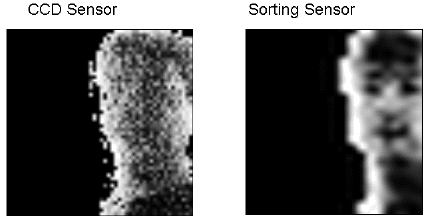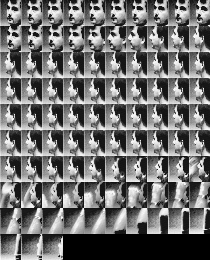
The high dynamic range scenario is created in an office setting with a back illuminated subject. A CCD camera has a limited dynamic range and images the subject as a silhouette. The sorting computational sensor, on the other hand, adjusts its dynamic range to view both bright and dark regions. In fact, the sorting image sensor provides more per pixel information than can be shown here in 8-bit-per-pixel image.
*The sorting sensor is an early 21x26-pixel prototype

To overcome the 8-bit limitation and aid the
presentation, both images are segmented into bright and dark regions. The
bright regions are “painted” black, while the raw data of
the dark region are amplified by 2. With this transformation additional
bits provided by the sorting sensor become visible.
Both CCD and sorting sensor images underwent this processing.
CCD wasn't providing information in the face and any post processing is
useless.



